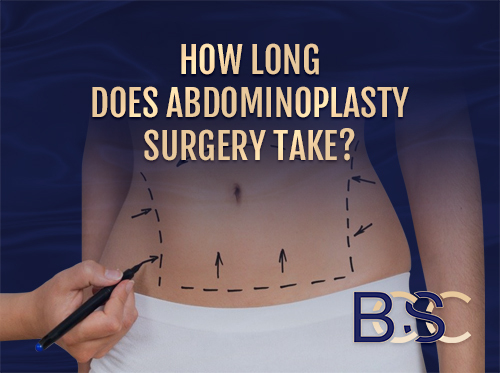Abdominoplasty Vs. Lipectomy
Fat removal is one of the most popular reasons people opt for plastic surgery. And, as many of us know all too well, the belly is one of the most problematic areas when it comes to excess fat. There’s nothing uncommon about stubborn belly fat. Sometimes, even rigorous exercise and dieting aren’t enough to get rid of those little fat deposits on your lower belly.
To treat these problems, many people turn to body contouring surgeries. Two procedures most commonly associated with fat removal are abdominoplasties and lipectomies.
Understanding the Difference between Abdominoplasty and Lipectomy
What sets these popular plastic surgery procedures apart? The simplest way to illustrate the difference between an abdominoplasty and a lipectomy is to break them down to their literal translations. Let’s have a look.
Abdominoplasties get their name from two root words. The Latin abdominis (which means abdomen), and the Greek suffix plasty, meaning “mould” or “shape.” Therefore, an abdominoplasty is literally a surgery that reshapes the patient’s abdomen.
Lipectomy is wholly rooted in ancient Greek. The first component is derived from lipo, the Greek word for fat, and ectomy is a suffix that means “to cut out” or “to remove.” So, lipectomies simply involve the removal of fat.
Lipectomy is generally used to refer to the excision of skin and fat. It is an umbrella term used for a range of operations.
An abdominoplasty is a lipectomy however an abdominoplasty does much more than remove skin and fat.
Types of lipectomies
Every patient’s needs are unique. That’s why specialist surgeons are trained to perform various different types of lipectomy surgeries. Depending on the amount of fat and excess skin, your surgeon will determine which type of procedure is best for you.
Mini-Abdominoplasty (mini abdominal lipectomy)

Mini Abdominoplasty
Disclaimer: Operation performed by Dr Bernard Beldholm. Adult content, surgery has risks, individual results vary, seek 2nd opinion. Please see the full disclaimer.
Some abdominoplasty patients have just a small deposit of fat or a little excess loose skin on the lower belly. When the problem area is that small and situated below the navel, a mini-abdominoplasty is the best option. This procedure does not affect the upper abdomen and only leaves a small scar along the patient’s bikini line.
Full Abdominoplasty (full abdominal lipectomy)
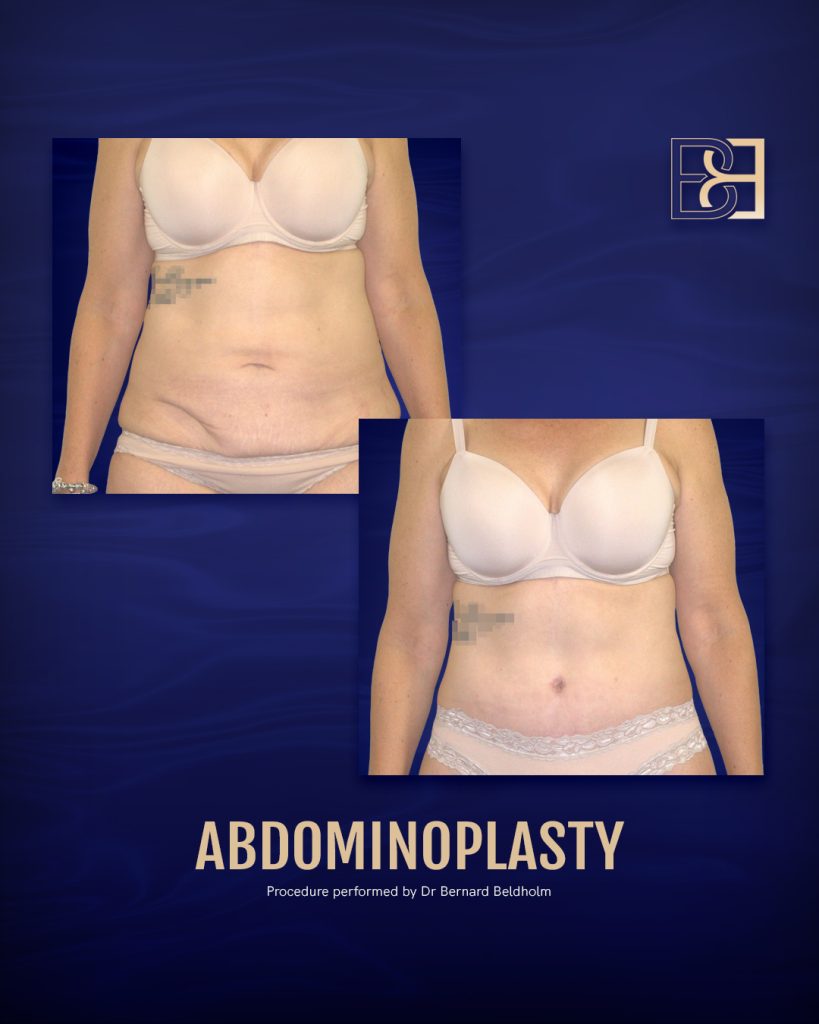
Full Abdominoplasty
Disclaimer: Operation performed by Dr Bernard Beldholm. Adult content, surgery has risks, individual results vary, seek 2nd opinion. Please see the full disclaimer.
The full abdominoplasty is the traditional version of this surgery and is what most people think of when they hear the term “tummy tuck.” Patients with loose skin and stretch marks can reshape their bodies after undergoing a significant amount of weight loss or pregnancy with a full abdominoplasty. This procedure alters the shape of your entire abdomen while leaving a scar that runs from hip to hip across the bikini line.
Extended Abdominoplasty (extended abdominal lipectomy)
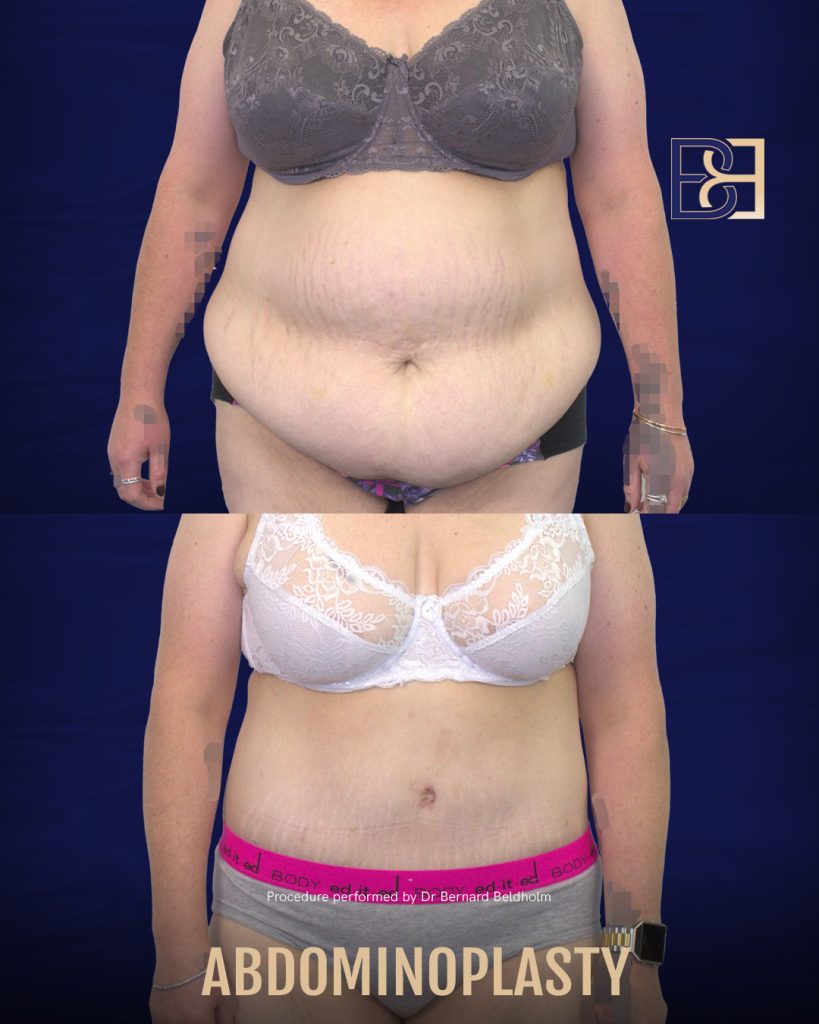
Extended Abdominoplasty
Disclaimer: Operation performed by Dr Bernard Beldholm. Adult content, surgery has risks, individual results vary, seek 2nd opinion. Please see the full disclaimer.
In certain cases, patients require work not just on the front of the abdomen but also the flanks. The hips tend to be a common area for fat to accumulate and loose skin to appear. The extended abdominoplasty corrects issues on the hips as well as the stomach. Since the scope of the operation is greater than a traditional abdominoplasty, the scar is also bigger, extending beyond the abdominal wall to the hip bones and around the patient’s flanks.
Fleur-de-Lis Abdominoplasty (Vertical and horizontal lipectomy)
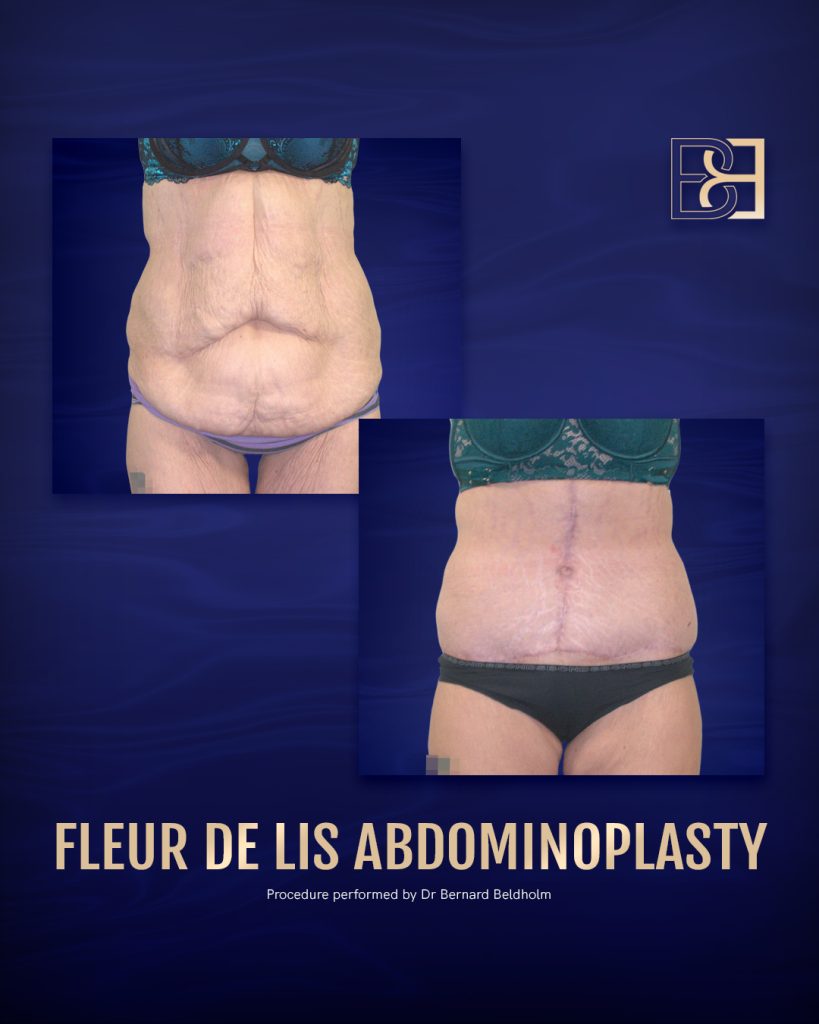
Fleur de lis Abdominoplasty
Disclaimer: Operation performed by Dr Bernard Beldholm. Adult content, surgery has risks, individual results vary, seek 2nd opinion. Please see the full disclaimer.
When patients undergo weight loss surgery such as a gastric bypass, the drastic weight loss that follows often leads to the formation of large skin folds. This is because the fatty tissue stretched out the patient’s skin and didn’t have time to shrink to accommodate the reduced body mass.
When faced with extensive abdomen reconstruction, specialist surgeons often recommend a fleur-de-lis abdominoplasty. This surgery gets its name from the two distinctive scars, which form a shape similar to the titular heraldry symbol. The first runs horizontally from hip to hip, and the second goes vertically up the front of the lower abdomen side, giving the appearance of an inverted T.
Body lift (Belt Lipectomy, circumferential lipectomy, 360-degree lipectomy)

Belt Lipectomy
Disclaimer: Operation performed by Dr Bernard Beldholm. Adult content, surgery has risks, individual results vary, seek 2nd opinion. Please see the full disclaimer.
Many patients wish to remove excess fat accumulated along their waistline. Their problem area roughly corresponds with a belt’s placement, hence the procedure’s name. Extra fatty tissue from the midsection is removed during a belt lipectomy. When the surgical procedure involves removing fat from lower body lift both the front and back, it is known as a circumferential lipectomy. This surgery leaves a scar that runs all the way around your abdomen.
Major Weight Loss Lipectomy
After undergoing major weight loss, people’s bodies bear the signs. Whatever the reason, sudden and drastic weight loss usually leads to large folds of stretched-out, loose skin. The arms, back, legs and thighs, flanks, and belly are all included in this surgery.
Brachioplasty (Arm Lift, Arm Lipectomy)
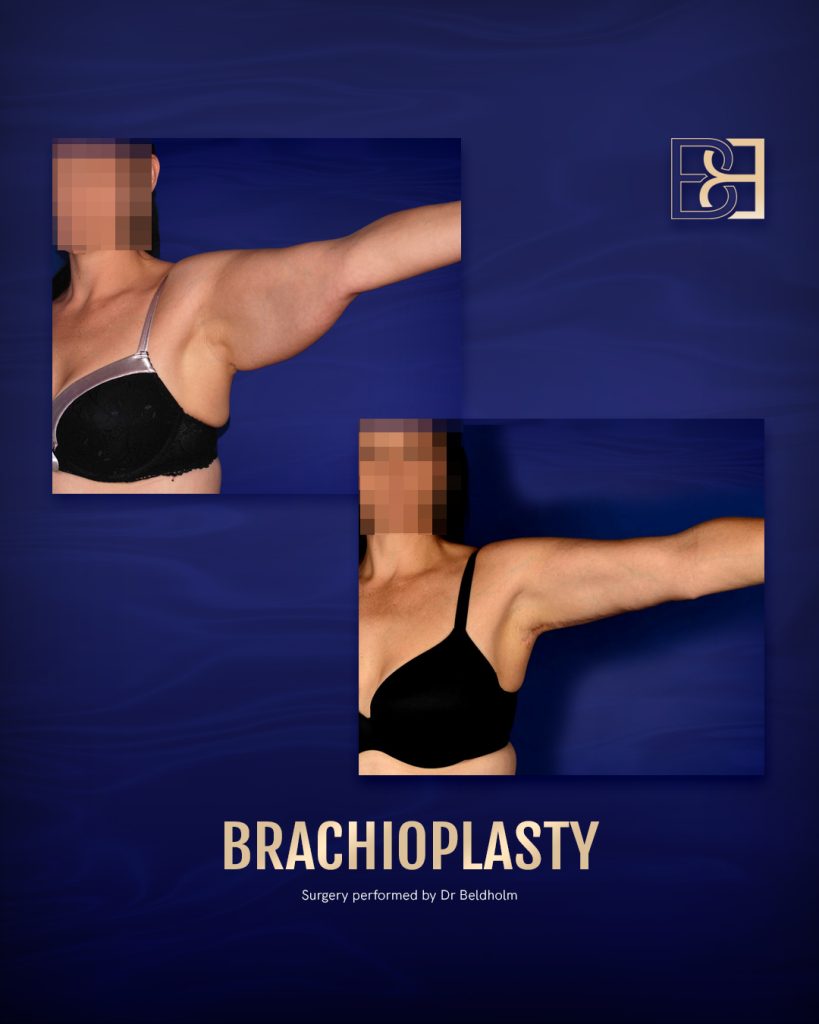
Brachioplasty
Disclaimer: Operation performed by Dr Bernard Beldholm. Adult content, surgery has risks, individual results vary, seek 2nd opinion. Please see the full disclaimer.
Along with the belly, the upper arms are another frequent site for stubborn fat. An arm lipectomy also called a brachioplasty, can help address this problem. Specialist surgeons who perform arm lifts will take care to leave a scar that can be easily concealed.
Thighplasty (Inner Thigh Lift, Thigh lipectomy)

Inner Thigh Lift
Disclaimer: Operation performed by Dr Bernard Beldholm. Adult content, surgery has risks, individual results vary, seek 2nd opinion. Please see the full disclaimer.
Having fatty tissue on your inner thighs can be quite uncomfortable. It tends to cause chafing, which can lead to rashes and boils forming in the affected area. An inner thigh lift is a lipectomy procedure that removes excess fat from the patient’s thighs and gives them a new shape.
Causes of Fat Accumulation and Loose Skin
Abdominoplasty and lipectomy surgeries are meant to treat excess fat and skin. But what inciting factors bring a person to the point where body contouring surgery is necessary? Opting to go under the knife is not always a simple question of aesthetics. Other valid reasons for having an abdominoplasty or belt lipectomy surgery are discussed below.
Weight Loss
People who are overweight or obese tend to have sagging skin after they lose weight. There is no exercise or non-surgical procedure to tighten excess skin and fat, leading many of them to choose a body contouring surgery to address the issue.
Age
Your face isn’t the only part of your body that shows signs of advancing age. As you get older, your skin inevitably starts to become more loose. This is due to your body slowing down its production of collagen and elastin, which leads to your skin becoming less supple.
Pregnancy
Pregnancy causes massive changes in a woman’s body. While some women see their body return to their pre-pregnancy shape naturally, others might require help. This is especially true if their abdominal muscles were torn during pregnancy. Such women might seek out an abdominoplasty or lipectomy after giving birth.
Genetics
Weight, stable weight gain and metabolism are strongly influenced by family genetics, just like how a person ages. All of these play a factor in where our bodies store fat and how fast we can burn it. Some people can achieve their goal weight and targeted fitness levels without surgery thanks to genetics, but it’s still a valid option for those who have difficulties doing so.
Lifestyle Choices
Drinking and smoking are two common, everyday vices that can lead to you needing an abdominoplasty or a lipectomy. The former plays a role in weight gain, while the second affects skin quality. Steering clear of them and making healthy lifestyle choices, such as eating clean and sleeping well, can spare you from having to get body contouring surgery.
Frequently Asked Questions
What is removed during a lipectomy?
A lipectomy is a cosmetic surgery procedure involving the removal of excess fat and loose skin. The methods could involve liposuction (using the force of suction to remove fat) or other, more advanced surgical procedures. The fat can be removed from various areas of the body, from the arms to the thighs. This same flexibility is what makes a lipectomy such a popular option for body contouring surgery.
What is the difference between a belt lipectomy and a circumferential abdominoplasty?
These are generally used as interchangeable terms.
Is lipectomy the same as liposuction?
No, lipectomy and liposuction are not the same procedure. While liposuction is minimally invasive, lipectomy involves a more extensive procedure. Liposuction is more limited in its scope, inserting a thin tube through small incisions to remove excess skin and fat from specific body areas. Lipectomy involves excision of skin and fat leaving a significant incision.
What is the difference between an apronectomy and an abdominoplasty?
As far as the scope of the surgeries is concerned, apronectomies and abdominoplasties exhibit significant differences. An apronectomy is intended to remove a large hanging fold of skin that resembles an apron’s flap in the front of the stomach and nothing else. An abdominoplasty also involves removing fatty tissue and repairing the abdominal muscles.
Apronectomies are performed on patients who have undergone massive weight loss. So are abdominoplasties, but they are also used to treat patients who might have suffered torn abdominal muscles, a condition known as diastasis recti.


